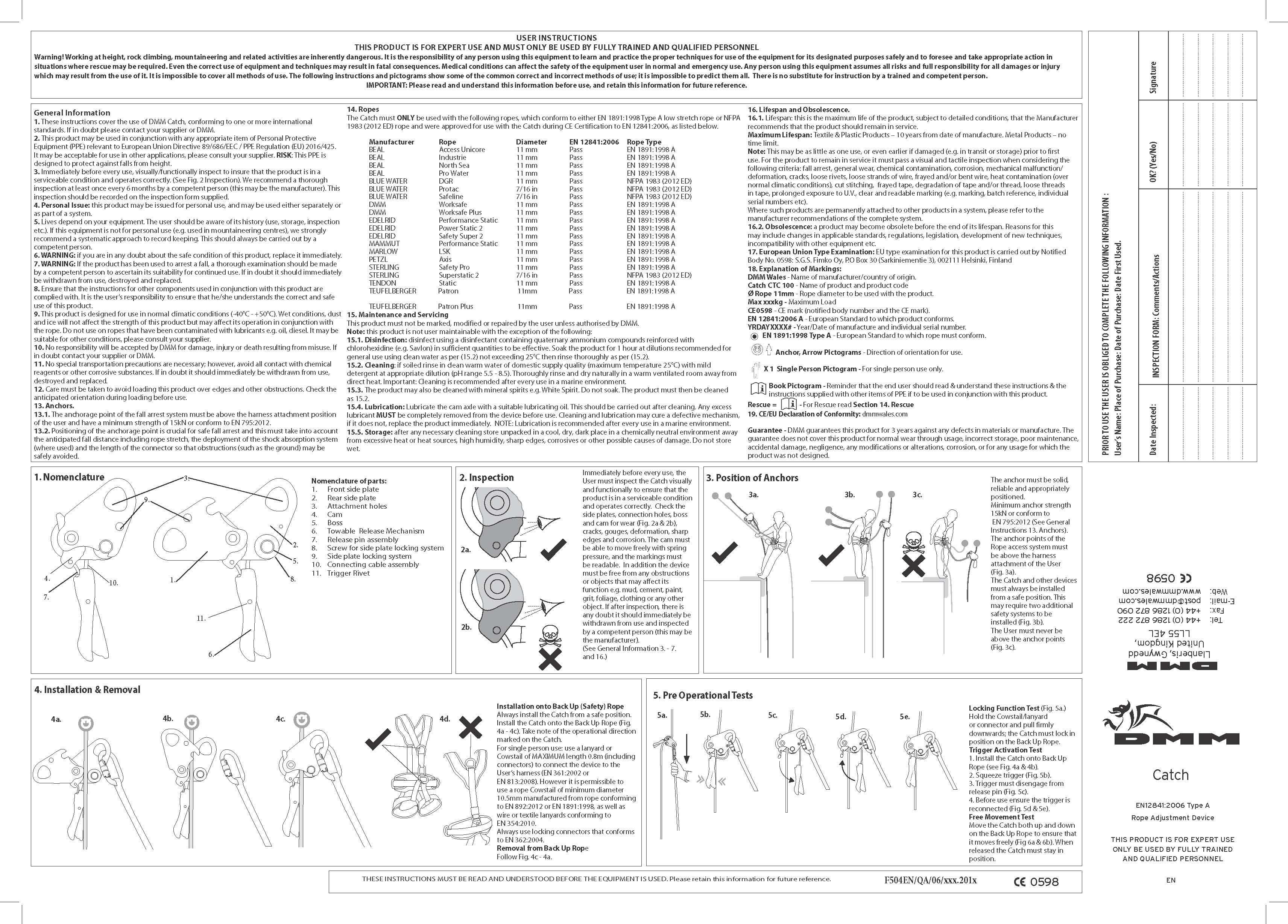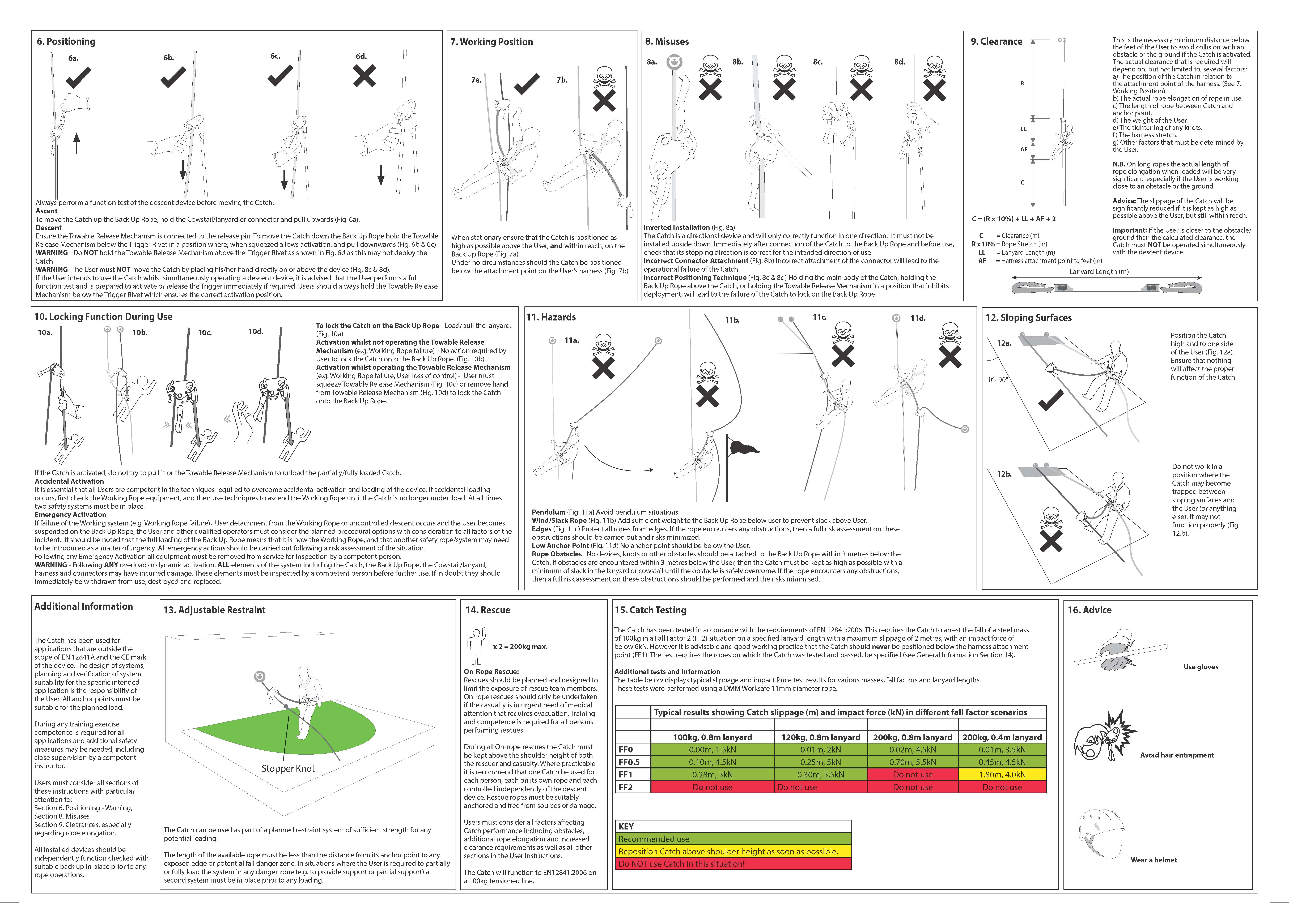Overview
[ Top
| BUD200
| Catch
| Return to Rope Grabs
]
Buddy BUD100
(#1863)
Technical Details
I acquired my DMM Buddy BUD100 from Backcountry Gear, 2015.
The DMM Buddy BUD100 is 103 mm. tall, 64 mm. wide, 28 mm. thick, and weighs 208 g. It is identical to the BUD200 except the anvil is 24.8 mm. in diameter, and the markings are different.
The front of the BUD100 has "BUDDY" and "DMM" in raised letters and a raised skeleton key icon near the locking screw hole. The front is printed with "BUD100," "ROPE Ø10.5-11mm," "EN353-2(2002)," "ANSI Z359.1(2007)," "www.dmmwales.com," "133540698M," and a Sieg Heil icon. The rear has "0120CE," a book icon, and "MADE IN WALES UK" raised in the forging process. The inside of the rear plate has a ring anchor icon, an up-pointing arrow, two lines indicating the rope path, "EN1891," "Ø10.5-11mm," and another Sieg Heil icon.
My comments on the BUD200 apply to the BUD100 as well.
[ Top
| BUD100
| Catch
| Return to Rope Grabs
]
Buddy BUD200
(#1777, 2641)
Technical Details
I acquired my DMM Buddy BUD200 from Arbor Tech Supply in 2012. I acquired another in 2017 as part of Bob Thrun’s collection.
My BUD200 is 64 mm. long, 103 mm. wide, 28 mm. high, and weighs 200 g.
The BUD200 consists of two forged aluminum body plates and several internal parts. Internally, there is a rocker lever on the left. This lever pivots on an 8 mm. post riveted to the rear plate. The lower end of the rocker lever is curved much like a typical lever-cam ascender cam, and six shallow grooves form low-relief teeth on the rope contact face.
Opposite the lower end of the lever is a fixed anvil, held in place by another 8 mm. pin. The anvil is cylindrical, 22.5 mm in diameter, with a 13.6 mm. diameter grooved extension to engage a notch in the front plate. A slot on the base of the cylindrical portion engages a rib in the back plate, preventing anvil rotation. There is a 4 mm. Allen cap screw in the bottom of the anvil. This is just a holding position, the crew can be used to lock the front plate closed as described later.
The front plate pivots independently on the same pin as the rocker lever, swinging counterclockwise to open.In the closed position, a notch on the left side of the front plate engages the end of the anvil pin.
The eye is subtriangular, measuring 23 mm. high and 24 mm. wide. A small hole in the front plate and a threaded hole in the rear plate allow locking the Buddy closed with a 4 mm. screw.
The front of the BUD200 has "BUDDY" and "DMM" in raised letters and a raised skeleton key icon near the locking screw hole. The front is printed with "BUD200," "ROPE Ø11-13mm," "EN353-2(2002)," "ANSI Z359.1(2007)," "www.dmmwales.com," "1100130015B," and a Sieg Heil icon. The rear has "0120CE," a book icon, and "MADE IN WALES UK" raised in the forging process. The inside of the rear plate has a ring anchor icon, an up-pointing arrow, two lines indicating the rope path, "EN1891," "Ø11-13mm," and another Sieg Heil icon.
The BUD200 is a nicely made rope grab. It will slide down the rope if not weighted. As usual, I am reluctant to jump over an edge to test whether a rope grab will catch me.
I like having a place to store the locking screw when it is not desired.
[ Top
| BUD100
| BUD200
| Return to Rope Grabs
]
Catch
(#2892)
Technical Details
I acquired my DMM Catch from Adventure Outdoors in 2021.
My DMM Catch is 203 mm. long, 71 mm. wide, 34 mm. high, and weighs 312 g.
The Catch is similar to the Buddy, so I will gray the descriptive text that applies to both.
The Catch consists of two forged aluminum body plates, several internal parts, and a towable release mechanism. Internally, there is a rocker lever on the left. This lever pivots on an 8 mm. post riveted to the rear plate. The lower end of the rocker lever is curved much like a typical lever-cam ascender cam, and six shallow grooves form low-relief teeth on the rope contact face.
Opposite the lower end of the lever is a fixed anvil, held in place by another 8 mm. pin. The anvil is cylindrical, 22.9 mm in diameter, with a 13.6 mm. diameter grooved extension to engage a notch in the front plate. A slot on the base of the cylindrical portion engages a rib in the back plate, preventing anvil rotation. There is a 4 mm. Allen cap screw in the bottom of the anvil. This is just a holding position, the crew can be used to lock the front plate closed as described later.
The front plate pivots independently on the same pin as the rocker lever, swinging counterclockwise to open.In the closed position, a notch on the left side of the front plate engages the end of the anvil pin.
The eye is subtriangular, measuring 23 mm. high and 24 mm. wide. A small hole in the front plate and a threaded hole in the rear plate allow locking the Buddy closed with a 4 mm. screw.
The towable release mechanism is a two-part assembly made from a cast metal body and a pivoting plastic arm. A 2 mm. stainless steel cable connects the top of body to a crimped eye that is screwed to the Catch's back plate. The connection allows the cable to pivot. The cable is covered with six 10 mm. plastic loosely-fitting plastic sleeves. A short, separate cable is attached to the cam toe with a set screw. The lower end of this cable has a crimped bullet. The plastic arm of the towable release mechanism opens to admit the bullet, and then a spring closes the arm to hold the bullet. Squeezing the lower end of the towable release mechanism releases the bullet.
The front of the Catch has "DMM" in raised letters and a raised skeleton key icon near the locking screw hole. The front is printed with "Pat Apps EP2641635, GB2500483," "CATCH," "CTC 100," "EN12841:2008 Type A," "ROPE Ø11mm," "•EN1998:1998 Type A," "150611671A," and "100kg=[a Sieg Heil icon]x1." The rear has "0120CE," a book icon, and "MADE IN WALES UK" raised in the forging process. It is printed with "RESCUE = [a book-with-an-"i" icon]." The inside of the rear plate has a ring anchor icon, "↑," two lines indicating the rope path, "EN1891," another ring anchor icon, and another "↑."
Cavers and climbers discovered long ago that having an independent safety line while rappelling was a safety hazard because of the lines' tendency to tangle, and so the industrial safety experts mandated its use. The idea is that the person would rappel on one line and have a safety slide down the other line, ready to save the rappeller when they lose control. But how do you get the safety to descend? One idea is for the use to hold it in the disengaged position, and release it at the same time as they abandon control of their own rappel. Testing shows that this does not work. Another possibility is to have a complex inertia-reel that locks up under high speed. The Petzl ASAP takes this approach. DMM's solution with the Catch was to provide a "towable release mechanism." By using their balance hand for something other than balance, the rappeller can pull the "safety" down the "safety" rope. When they decide to lose control of the rappel, they can then either let go (this probably won't work) or they can panic and squeeze the release lever, giving the cam freedom to grab.
Most of the obvious ways to hold the towable release mechanism don't work well, as squeezing tighter does not actuate the release lever. It is essential that the rappeller hold the mechanism below the pivot. The mechanism is small, so people with large hands will find that only a few fingertips grasp the mechanism. It is easy to accidentally let go of the mechanism, and this will leave the rappeller hanging from their "safety. The rappeller must then extricate him/herself, which is not as easily done with industrial harnesses and equipment as it is with normal vertical caving gear. The rappeller must act quickly, as DMM warns, "On-rope rescues should only be undertaken if the casualty is in urgent need of medical attention that requires evacuation."
Anyone reading these comments should detect my tone of scathing sarcasm. I think that the design is clever, but that it missed the point in several aspects, and I do not recommend it for normal caving or climbing applications.
[ Top
| BUD100
| BUD200
| Catch
]




